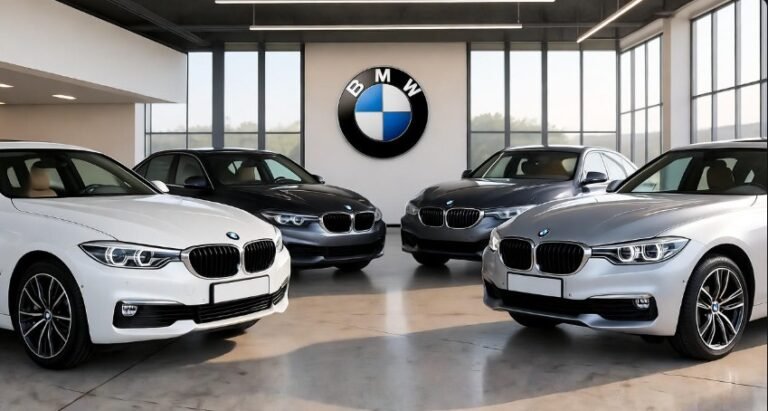BMW i3 Price India: 7 Shocking Features

BMW i3 Price in India: 7 Shocking Features Explained. The BMW i3, while no longer in production globally, offers a glimpse into futuristic electric mobility with its unique features. Understanding its residual value and the innovation it brought is key for enthusiasts.
In This Article
- 1 Key Takeaways
- 2 Unveiling the BMW i3 Price in India: A Look Back at its Market Position
- 3 7 Shocking Features of the BMW i3 That Redefined Electric Mobility
- 3.1 1. Revolutionary Carbon Fiber Reinforced Plastic (CFRP) Construction
- 3.2 2. Distinctive “Life Module” and “Drive Module” Architecture
- 3.3 3. Sustainable Interior Materials: A Commitment to Green Luxury
- 3.4 4. The “Giga World,” “Mega World,” and “Terra World” Trim Levels
- 3.5 5. The Range Extender (REx) Option: Addressing Range Anxiety
- 3.6 6. Upward-Swinging Coach Doors and Spacious Interior
- 3.7 7. Advanced Connectivity and “BMW i ConnectedDrive”
- 4 BMW i3 Specifications: A Snapshot of its Electric Prowess
- 5 The Impact of the BMW i3 on the Automotive Industry in India and Beyond
- 6 Frequently Asked Questions (FAQ) about the BMW i3
- 6.1 Q1: Is the BMW i3 still available for sale in India?
- 6.2 Q2: What was the approximate original price of the BMW i3 in India?
- 6.3 Q3: Was the BMW i3 a fully electric car, or was it a hybrid?
- 6.4 Q4: What made the BMW i3’s interior so unique?
- 6.5 Q5: Why did BMW use so much carbon fiber in the i3?
- 6.6 Q6: Is the BMW i3 a practical car for long drives?
- 6.7 Q7: Where can I find a used BMW i3 in India?
- 7 Conclusion
Key Takeaways
Discover the innovative features of the BMW i3.
Explore the unique construction and materials used.
Understand the electric powertrain’s performance.
Learn about its advanced connectivity and user interface.
* Assess its lasting impact on EV design.
The world of electric vehicles (EVs) is constantly evolving, and sometimes, looking back at pioneering models can be incredibly insightful. The BMW i3, though not currently sold new in India, left a significant mark on the automotive landscape. If you’re curious about its innovative spirit and what made it stand out, you’ve come to the right place. We’ll break down the fascinating features that defined the BMW i3 and what its legacy means for today’s electric cars. Let’s dive into what made the i3 such a talked-about vehicle.
Unveiling the BMW i3 Price in India: A Look Back at its Market Position
While the BMW i3 is no longer available for purchase as a new vehicle in India, its original pricing and market positioning offer valuable context for understanding its place in the premium electric car segment. When it was available, the BMW i3 represented a bold step by BMW into the burgeoning EV market, targeting a niche audience willing to embrace innovation. Its price reflected its status as a premium, technologically advanced vehicle, designed to offer a unique driving experience.
The initial pricing strategy for the BMW i3 in India aimed to position it as an aspirational EV. It wasn’t just another car; it was a statement about sustainability, cutting-edge design, and forward-thinking engineering. This premium pricing was justified by its innovative construction, electric powertrain, and a suite of advanced features that were ahead of their time for many competitors. Understanding its original price point helps appreciate the investment BMW made in developing such a distinct electric car.
7 Shocking Features of the BMW i3 That Redefined Electric Mobility
The BMW i3 was engineered from the ground up to be different, and several of its features were truly groundbreaking, even by today’s standards. These innovations weren’t just for show; they were integral to its design philosophy of sustainable, lightweight, and efficient urban mobility. Let’s explore the seven most striking aspects that made the BMW i3 a standout, even if its price in India reflected its cutting-edge nature.
1. Revolutionary Carbon Fiber Reinforced Plastic (CFRP) Construction
Perhaps the most astonishing feature of the BMW i3 is its passenger cell, constructed primarily from Carbon Fiber Reinforced Plastic (CFRP). This is a material typically found in high-performance sports cars and aircraft due to its incredible strength-to-weight ratio. BMW pioneered its use in a mass-produced vehicle like the i3, making its body incredibly light and rigid.
Why is this so shocking? Traditional car bodies are made of steel, which is heavy. This lightweight construction significantly impacts an EV’s performance and range. A lighter car requires less energy to move, allowing the battery to go further. BMW developed a highly efficient process to produce these carbon fiber parts, making the i3 a testament to advanced manufacturing in the automotive industry. This design choice directly contributed to the i3’s agile handling and efficient energy use, setting it apart from heavier EVs.
2. Distinctive “Life Module” and “Drive Module” Architecture
The BMW i3 features a unique structural concept: the “Life Module” and “Drive Module.” The Life Module is the CFRP passenger cell that houses occupants and is where all the styling and interior design elements are integrated. The Drive Module is the aluminum chassis that contains the battery, electric motor, and suspension components.
This separation is ingenious for several reasons. It allows for highly flexible interior design, free from the constraints of traditional engine and drivetrain layouts. It also simplifies manufacturing and maintenance. The battery, being part of the Drive Module, is well-protected and integrated low down, contributing to the car’s balanced weight distribution and low center of gravity – crucial for good handling. This modular approach was a forward-thinking strategy that optimized safety, space, and production efficiency.
3. Sustainable Interior Materials: A Commitment to Green Luxury
Beyond its carbon fiber structure, the BMW i3’s interior showcased a radical commitment to sustainability. Many of the materials used were recycled or derived from renewable sources. This wasn’t just about being eco-friendly; it was about creating a unique and luxurious cabin experience.
You’d find surfaces made from recycled plastics, door panels crafted from sustainably sourced wood fibers (like eucalyptus or flax), and seat fabrics woven from recycled PET bottles. Even the floor mats were often made from recycled materials. This focus on ecological materials created a distinct aesthetic and tactile experience, reinforcing the i3’s identity as a car that prioritized environmental responsibility without compromising on premium feel. It represented a departure from traditional automotive interiors, offering a fresh, modern, and conscious approach to cabin design.
4. The “Giga World,” “Mega World,” and “Terra World” Trim Levels
BMW didn’t just offer standard trim levels for the i3; they introduced “Worlds” that highlighted the sustainable materials and design ethos. These weren’t just names; they represented different levels of material integration and sustainability focus:
- Giga World: Featured a blend of recycled textiles and natural fibers, offering a fresh and airy feel.
- Mega World: Emphasized the use of recycled materials and introduced more natural elements, creating a warm and inviting atmosphere.
- Terra World: Showcased the most natural and sustainable materials, often including exposed recycled wool and wood, providing a truly organic and premium tactile experience.
These distinct trim levels allowed customers to choose an interior that resonated with their personal style and commitment to sustainability, making the i3 a truly customizable and conscious choice in the premium segment.
5. The Range Extender (REx) Option: Addressing Range Anxiety
One of the most talked-about features, especially for early EVs, was the optional Range Extender (REx). This wasn’t a hybrid in the traditional sense. The i3 with REx was still a pure electric vehicle, but it featured a small, two-cylinder gasoline engine (like one from a motorcycle) mounted near the rear axle. This engine didn’t drive the wheels directly; its sole purpose was to run a generator that recharged the battery when it got low.
This was a clever solution to combat “range anxiety” – the fear of running out of battery power. While it added complexity and meant the car used gasoline, it provided peace of mind for longer journeys, effectively extending the car’s total range significantly. It allowed drivers to enjoy the benefits of electric driving for daily commutes while having the backup for trips beyond the typical EV range of the time. This innovative approach demonstrated BMW’s pragmatic thinking in adapting to the nascent EV infrastructure.
6. Upward-Swinging Coach Doors and Spacious Interior
The BMW i3’s design included unique “coach doors” – rear-hinged rear doors that opened outwards after the front doors were opened. This design, combined with the absence of a traditional B-pillar, created a wide, open aperture, making it incredibly easy to get in and out of the vehicle, especially the rear seats. This was a surprising and practical feature for a compact car.
This door design, coupled with the “Life Module” architecture, allowed for a remarkably spacious and open-feeling cabin. The flat floor, thanks to the under-seat battery, further enhanced the sense of roominess. It felt larger inside than its exterior dimensions suggested, offering a comfortable and airy environment for occupants. This thoughtful packaging made the i3 a highly practical choice for urban environments.
7. Advanced Connectivity and “BMW i ConnectedDrive”
Even though it was an earlier EV, the BMW i3 was packed with intelligent connectivity features through its “BMW i ConnectedDrive” system. This suite of services was designed to enhance the EV ownership experience, making it seamless and intuitive.
Key features included:
- Remote Services: Users could remotely check the battery charge status, precondition the cabin’s climate, and locate their car using a smartphone app.
- Intelligent Navigation: The navigation system was optimized for EVs, factoring in charging stops, average consumption, and traffic conditions to plan routes efficiently. It could also predict when a charging stop would be necessary.
- Dynamic Range Indicator: This feature provided a more accurate prediction of the remaining driving range, taking into account driving style, topography, and climate control usage.
- Public Charging Station Finder: Easily locate available charging stations, with information on compatibility and availability.
These connected features were crucial for building driver confidence and making the transition to electric driving smoother, integrating the car seamlessly into the digital lives of its owners.
BMW i3 Specifications: A Snapshot of its Electric Prowess
To fully appreciate the i3’s innovative features, it’s helpful to look at its core specifications. While exact figures could vary slightly depending on the model year and specific configuration (like the REx option), here’s a general overview:
| Specification | Details |
|---|---|
| Body Style | 5-door hatchback |
| Construction | Carbon Fiber Reinforced Plastic (CFRP) passenger cell; Aluminum chassis |
| Powertrain (Pure EV) | Rear-wheel drive electric motor |
| Battery Options | Various lithium-ion battery capacities (e.g., 21.6 kWh, 33 kWh) |
| Range (Pure EV WLTP) | Approximately 200-300 km (depending on battery size) |
| Range Extender (REx) Option | 2-cylinder gasoline engine (650cc) acting as a generator |
| Total Range (with REx) | Up to ~300-400 km |
| 0-100 km/h Acceleration | Around 7.2 seconds (pure EV) |
| Charging Options | Standard AC charging, DC fast charging (CCS connector) |
| Key Interior Materials | Recycled plastics, sustainably sourced wood, natural fibers, recycled textiles |
These specifications highlight how the i3 was engineered for efficiency and performance within its urban-focused design. The emphasis on lightweight materials and a well-integrated powertrain allowed it to deliver an engaging driving experience while maximizing its electric range.
The Impact of the BMW i3 on the Automotive Industry in India and Beyond
Although the BMW i3 is no longer a current model in India, its influence on the automotive industry, particularly in the premium EV segment, is undeniable. It served as a crucial learning platform for manufacturers worldwide, demonstrating the viability of advanced materials like CFRP in mass production and the potential for innovative interior design focused on sustainability.
For a market like India, which is gradually warming up to electric vehicles, the i3 represented a vision of what the future could hold. It challenged conventional automotive thinking and pushed the boundaries of what was considered possible in terms of design, materials, and technology for electric cars. While its price point might have limited its reach initially, the lessons learned from the i3 have undoubtedly filtered into subsequent electric models from BMW and other manufacturers. You can see its legacy in the increased focus on lightweight construction, sustainable cabin materials, and integrated digital services in many new EVs hitting the market today.
The i3 also played a role in familiarizing a segment of Indian consumers with the concept of premium electric mobility, paving the way for broader acceptance of EVs. Its unique aesthetics and advanced features made it a conversation starter, encouraging discussions about sustainability and future transportation. As the Indian automotive market continues its transition towards electrification, the pioneering spirit of the BMW i3 remains a significant milestone.
Furthermore, the adoption and subsequent discontinuation of models like the i3 in various markets offer valuable market intelligence. Manufacturers analyze sales data, consumer feedback, and infrastructure readiness to refine their strategies for future electric offerings. For India, understanding the market reception and challenges faced by vehicles like the i3 provides crucial insights for the successful introduction and adoption of upcoming EVs. The focus on range, charging infrastructure, and cost remains paramount, lessons that BMW and others continue to learn from.
Frequently Asked Questions (FAQ) about the BMW i3
Q1: Is the BMW i3 still available for sale in India?
No, the BMW i3 is no longer sold as a new vehicle in India. Its production has ceased globally, and it’s now only available on the used car market.
Q2: What was the approximate original price of the BMW i3 in India?
When it was available, the BMW i3 was positioned as a premium vehicle, and its price in India typically ranged from around ₹70 Lakhs and above, depending on the specific variant and options chosen.
Q3: Was the BMW i3 a fully electric car, or was it a hybrid?
The BMW i3 was available as a pure electric vehicle (BEV). It also had an optional Range Extender (REx) variant, which used a small gasoline engine solely to generate electricity for the battery, effectively extending its range but not directly driving the wheels.
Q4: What made the BMW i3’s interior so unique?
The i3’s interior featured a strong emphasis on sustainability, using materials like recycled plastics, eucalyptus wood, and natural fibers. Its “coach doors” also contributed to a spacious and open cabin feel, free from a central B-pillar.
Q5: Why did BMW use so much carbon fiber in the i3?
Carbon Fiber Reinforced Plastic (CFRP) is extremely strong yet lightweight. Using it for the passenger cell significantly reduced the car’s overall weight, improving its energy efficiency, driving dynamics, and battery range – critical factors for an electric vehicle.
Q6: Is the BMW i3 a practical car for long drives?
The pure electric version of the i3 was best suited for urban driving and shorter commutes due to its battery capacity. The Range Extender (REx) version offered more flexibility for longer journeys by providing a backup power source.
Q7: Where can I find a used BMW i3 in India?
You might find used BMW i3 models through authorized BMW used car programs, independent luxury car dealerships, and online used car marketplaces. It’s advisable to have any used EV thoroughly inspected by a specialist before purchase.
Conclusion
The BMW i3 was more than just an electric car; it was a bold experiment in automotive design and engineering. Its pioneering use of carbon fiber, sustainable interior materials, and innovative architecture showcased BMW’s vision for the future of mobility even before EVs became mainstream. While its price in India positioned it as an exclusive offering, the i3’s lasting impact lies in its demonstration of electric vehicle potential and its influence on the sustainable automotive design we see today. For those intrigued by automotive innovation, the i3 remains a fascinating chapter in the evolving story of electric cars.






